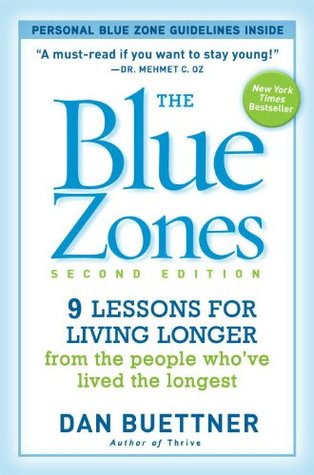More on this book
Community
Kindle Notes & Highlights
by
Dan Buettner
Read between
January 29 - February 2, 2022
fasting almost half of the year. Caloric restriction—a type of fasting that cuts about 30 percent of calories out of the normal diet—
Make family and friends a priority. Ikarians foster social connections,
people who weren’t connected to their communities had a 50 percent greater chance of dying
Your Personal Blue Zone Putting the Blue Zones Lessons to Work in Your Life
FIRST STEPS Start down the road to longevity To begin, go to the Blue Zones website at www.bluezones.com. There, you’ll find the Vitality Compass™,
Research shows that if you dedicate yourself to a new practice for as little as five weeks, the practice is more likely to become a habit.
time frame for behaviors to become habitual that ranges from 5 to 12 weeks.
Don’t try more than three secrets at a time.
LESSON ONE: MOVE NATURALLY Be active without having to think about it
engage in regular, low-intensity physical activity, often as part of a daily work routine.
exercising the core muscle groups at least twice a week.
practicing standing on one foot during the day (maybe when brushing your teeth) would be a small step toward improving your balance.
get into the habit of doing at least 30 minutes (ideally at least 60 minutes) of exercise at least five times a week.
taking the stairs, can add up to a more active lifestyle.
At work, take a walking break instead of a coffee and donut break. Build activity into your routine and lifestyle.
Walk. This is the one activity that all successful centenarians did—and do—almost daily.
After a hard day, a walk can relieve stress; after a meal, it can aid digestion.
Enroll in a yoga class. Be sure to practice it at least twice weekly.
LESSON TWO: HARA HACHI BU Painlessly cut calories by 20 percent
hara hachi bu—a reminder to stop eating when their stomachs are 80 percent full.
size of the plates and glasses we use has a profound impact on how much we consume.
Use small vessels. Drop your dinner plates and big glasses off at a charity, and buy smaller plates and tall, narrow glasses. You’re likely to eat significantly less without even thinking about it.
Eat more slowly. Eating faster usually results in eating more.
Focus on food.
If you’re going to eat, just eat. You’ll eat more slowly, consume less, and savor your food more.
Making a habit of eating only while sitting down—eating purposefully—better enables us to appreciate the tastes and textures of our food.
Eat early. In the Blue Zones, the biggest meal of the day is typically eaten during the first half of the day. Nicoyans, Okinawans, and Sardinians eat their biggest meal at midday, while Adventists consume many of their calories for breakfast.
right ingredients (whole grains, fruits, milk, nut butter), you’ll fuel your body for most of the day and have fewer cravings for sugary or fatty foods.
LESSON THREE: PLANT SLANT Avoid meat and processed foods
they ate small portions of unprocessed foods.
While we don’t need a lot of protein in our diets, we should eat some protein at every meal. Protein helps us feel fuller, and helps us avoid the peaks and valleys in our blood sugar levels that make us feel hungry.”
Diets rich in legumes are associated with fewer heart attacks
Legumes are a good dietary source of healthy flavonoids and fiber (which can reduce the risk of heart attack) and are also an excellent nonanimal source of protein.
Tofu (bean curd), a daily feature in the ...
This highlight has been truncated due to consecutive passage length restrictions.
An excellent source of protein without the side effects of meat, tofu contains a compound, phytoestrogen, which may provide heart-protective properties to women.
Nuts are perhaps the most impressive of all “longevity foods.”
those who ate nuts at least five times a week had a rate of heart disease that was half that of those who rarely ate nuts.
Studies have indicated that nuts may help protect the heart by reducing total blood cholesterol levels.
nuts are rich in monounsaturated fat and soluble fiber, both of which tend to lower LDL
good sources of vitamin E and other possibly heart-protective nutrients. The best nuts are almonds, peanuts, pecans, pistachios, hazelnuts, walnuts, and some pine nuts. Brazil nuts, cashews, and macadamias have a little more saturated fat and are less desirable. But all nuts are good.
Eat four to six vegetable servings daily. Blue Zone diets always include at least two vegetables at each meal. Limit intake of meat.
Lead with beans. Beans are a cornerstone of each of the Blue Zone diets. Make beans—or tofu—the centerpiece of lunches and dinners.
Eat nuts every day.
PURPOSE NOW Take time to see the big picture Okinawans call it ikigai, and Nicoyans call it plan de vida, but in both cultures the phrase essentially translates to “why I wake up in the morning.”
something to get up for in the morning, something that made a difference
Claremont University psychologist Dr. Mihály Csíkszentmihályi best describes this feeling in his book, Flow: The Psychology of Optimal Experience.
flow as a Zen-like state of total oneness with the activity at hand in which you feel fully immersed in what you’re doing. It’s characterized by a sense of freedom, enjoyment, fulfillment, and skill,
“Doing things that are novel and complex. Once you get good at them, and they are no longer novel, then you move on to something else.
To realize your purpose, try the following tips. Craft a personal mission statement.
Begin by answering this question in a single, memorable sentence: Why do you get up in the morning?


